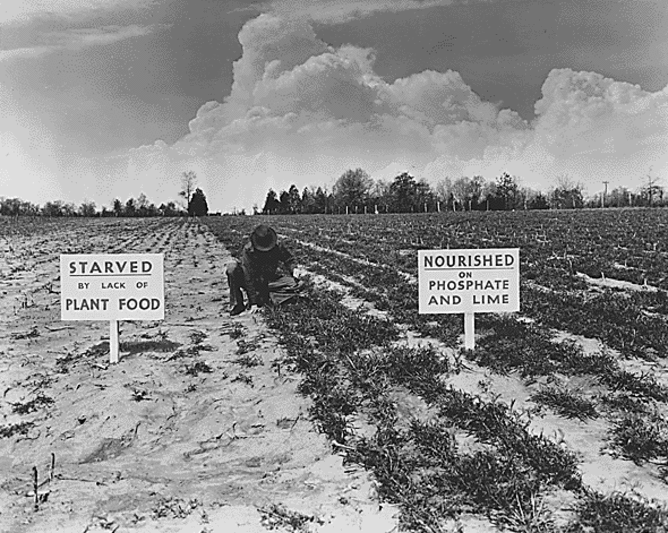How the great phosphorus shortage could leave us short of food

You know that greenhouse gases are changing the climate. You probably know drinking water is becoming , and that we're living through a mass extinction.
But when did you last worry about phosphorus?
It's not as well-known as the other issues, but phosphorus depletion is no less significant. After all, we could live without cars or unusual species, but if phosphorus ran out we'd have to live without food.
Phosphorus is an essential nutrient for all forms of life. It is a key element in our DNA and all living organisms require daily phosphorus intake to produce energy. It cannot be replaced and there is no synthetic substitute: without phosphorus, there is no life.
Our dependence began in the mid-19th century, after farmers noticed spreading phosphorus-rich guano (bird excrement) on their fields led to impressive improvements in crop yields. Soon after, mines opened up in the US and China to extract phosphate ore – rocks which contain the useful mineral. This triggered the current use of mineral fertilisers and, without this industrial breakthrough, humanity could only produce that it does today.
has quadrupled over the past half century and will continue rising as the population expands. The growing wealth of developing countries allows people to afford more meat which has a "" 50 times higher than most vegetables. This, together with the increasing usage of biofuels, is estimated the demand for phosphorus fertilisers by 2050.

Today phosphorus is also used in pharmaceuticals, personal care products, flame retardants, catalysts for chemical industries, building materials, cleaners, detergents and food preservatives.
Phosphorus is not a renewable resource
Reserves are limited and not equally spread over the planet. The only large mines are located in Morocco, Russia, China and the US. Depending on which scientists you ask, the world's phosphate rock reserves will last for to – though the more optimistic assessments rely on the discovery of new deposits.
It's a big concern for the EU and other countries without their own reserves, and phosphorus depletion could lead to geopolitical tensions. Back in 2008, when fertiliser prices sharply increased by 600% and directly influenced food prices, there were violent riots in 40 different developing countries.
Phosphorus also harms the environment. Excessive fertiliser use means it leaches from agricultural lands into rivers and eventually the sea, leading to so-called dead zones where most fish can't survive. Uninhibited algae growth caused by high levels of phosphorus in water has already created more than 400 coastal death zones worldwide. Related human poisoning costs dollars annually in the US alone.
With the increasing demand for phosphorus leading to massive social and environmental issues, it's time we looked towards more sustainable and responsible use.
There is still hope
In the past, the phosphorus cycle was closed: crops were eaten by humans and livestock while their faeces were used as natural fertilisers to grow crops again.
These days, . Each year of phosphate rocks are mined, but only a negligible amount makes it back into the soil. Crops are transported to cities and the waste is not returned to the fields but to the sewage system, which mainly ends up in the sea. A cycle has become a .
We could reinvent a modern phosphorus cycle simply by dramatically reducing our consumption. After all, less than of the phosphorus in fertilisers is actually taken up by plants; the rest accumulates in the soil or is washed away. To take one example, in the Netherlands there is enough phosphorus in the soil today to supply the country with fertiliser for the next .
Food wastage is also directly linked to phosphorus overuse. In the most developed countries, of discarded food is edible. We could also make agriculture smarter, optimising the amount of phosphorus used by specially selecting low-fertiliser crops or by giving chickens and pigs a that helps them digest phosphorus more efficiently and therefore avoid extensive use of phosphorus-heavy growth supplements.
It takes vast amounts of energy to transform phosphate ore into "elemental phosphorus", the more reactive and pure form used in other, non-agricultural sectors. Inventing a quicker route from raw rocks to industrially-useful compounds is one of the big challenges facing the future generation. The EU, which only has minimal reserves, is investing in aimed at saving energy – and phosphorus.
We could also close the phosphorus cycle by recycling it. Sewage, for instance, contains phosphorus yet it is considered waste and is mainly incinerated or released into the sea. The technology to extract this phosphorus and reuse it as fertiliser , but it's still at an early stage of development.
When considering acute future challenges, people do not often think about phosphorus. However, securing enough food for the world's population is at least as important as the development of renewable energy and the reduction of greenhouse gases. To guarantee long-term food security, changes in the way we use phosphorus today are vital.
Source: The Conversation
This article was originally published on . Read the .
![]()


















